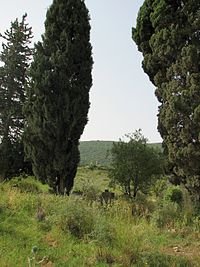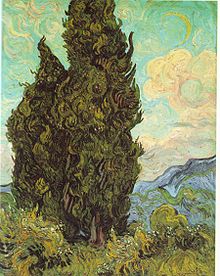- Cupressus sempervirens
-
Mediterranean Cypress 
Mediterranean Cypress foliage and cones Conservation status Scientific classification Kingdom: Plantae Division: Pinophyta Class: Pinopsida Order: Pinales Family: Cupressaceae Genus: Cupressus Species: C. sempervirens Binomial name Cupressus sempervirens
L.Cupressus sempervirens, the Mediterranean Cypress (also known as Italian, Tuscan, or Graveyard Cypress, or Pencil Pine) is a species of cypress native to the eastern Mediterranean region, in northeast Libya, southeast Greece (Crete, Rhodes), southern Turkey, Cyprus, Northern Egypt, western Syria, Lebanon, Israel, Malta, Italy, western Jordan, and also a disjunct population in Iran.
It is a medium-sized evergreen tree to 35 m (115 ft) tall, with a conic crown with level branches and variably loosely hanging branchlets[1]. It is very long-lived, with some trees reported to be over 1,000 years old.
The foliage grows in dense sprays, dark green in colour. The leaves are scale-like, 2-5 mm long, and produced on rounded (not flattened) shoots. The seed cones are ovoid or oblong, 25-40 mm long, with 10-14 scales, green at first, maturing brown about 20–24 months after pollination. The male cones are 3-5 mm long, and release pollen in late winter.
It is moderately susceptible to cypress canker, caused by the fungus Seiridium cardinale, and can suffer extensive dieback where this disease is common.
The species name sempervirens comes from the Latin for 'evergreen'.
Contents
Uses
Mediterranean Cypress has been widely cultivated as an ornamental tree for millennia away from its native range, mainly throughout the central and western Mediterranean region, and in other areas with similar hot, dry summers and mild, rainy winters, including California, southwest South Africa and southern Australia. It can also be grown successfully in areas with cooler, moister summers, such as the British Isles, New Zealand and the Pacific Northwest (coastal Oregon, Washington and British Columbia). It is also planted in south Florida as an ornamental tree. In some areas, particularly the U.S., it is known inaccurately as "Italian" or "Tuscan Cypress"; although the species is very commonly cultivated in Italy, it is not native there.
The vast majority of the trees in cultivation are selected cultivars with a fastigiate crown, with erect branches forming a narrow to very narrow crown often less than a tenth as wide as the tree is tall. The dark green 'exclamation mark' shape of these trees is a highly characteristic signature of Mediterranean town and village landscapes. Formerly, the species was sometimes separated into two varieties, the wild C. sempervirens var. sempervirens (syn. var. horizontalis), and the fastigiate C. s. var. pyramidalis (syn. var. fastigiata, var. stricta), but the latter is now only distinguished as a Cultivar Group, with no botanical significance.
It is also known for its very durable, scented wood, used most famously for the doors of St. Peter's Basilica in the Vatican City, Rome.
Cypress used to be used in distilleries as staves to hold mash ferments to make alcohol before the invention of stainless steel.[2]
Commonly seen throughout New Mexico, the Mediterranean Cypress is also known as the "drama tree" because of its tendency to bend with even the slightest of breezes.
Iran's ancient cypresses
Cypress, Cupressus sempervirens was the first choice for Iranian Gardens. In all of the famous Persian Gardens, such as Fin Garden, Mahaan, Dowlat-Abad, and others, this tree plays a central role in their design.[citation needed] The oldest living Cypress is the Sarv-e-Abarkooh in Iran's Yazd Province. Its age is estimated to be approximately 4,000 years.[3]
Symbolism
In classical antiquity, the cypress was a symbol of mourning and in the modern era it remains the principal cemetery tree in both the Muslim world and Europe.
In the classical tradition, the cypress was associated with death and the underworld because it failed to regenerate when cut back too severely. Athenian households in mourning were garlanded with boughs of cypress.[4] Cypress was used to fumigate the air during cremations.[5] It was among the plants that were suitable for making wreaths to adorn statues of Pluto, the classical ruler of the underworld.[6]
The poet Ovid, who wrote during the reign of Augustus, records the best-known myth that explains the association of the cypress with grief. The handsome boy Cyparissus, a favorite of Apollo, accidentally killed a beloved tame stag. His grief and remorse were so inconsolable that he asked to weep forever. He was transformed into cupressus sempervirens, with the tree's sap as his tears.[7] In another version of the story, it was the woodland god Silvanus who was the divine companion of Cyparissus and who accidentally killed the stag. When the boy was consumed by grief, Silvanus turned him into a tree, and thereafter carried a branch of cypress as a symbol of mourning.[8]
 Fastigiate Mediterranean Cypress Cupressus sempervirens 'Stricta', planted in Hawaii
Fastigiate Mediterranean Cypress Cupressus sempervirens 'Stricta', planted in Hawaii
In Greek mythology, the cypress is associated with both Artemis and Cyparissus, a boy beloved by Apollo. Ancient Roman funerary rites used it extensively. Cupressus sempervirens is the principal cemetery tree both in the Western and Muslim worlds. Cypresses are used extensively the Shahnameh, the great Iranian epic poem by Ferdowsi.
In Numerology, the Cypress tree (as a "birth tree") is nicknamed "The Faithfulness", and is a depiction of the following characteristics: Strong, muscular, adaptable, takes what life has to give, happy,content,optimistic, needs enough money and acknowledgment, hates loneliness, passionate lover which cannot be satisfied, faithful, quick-tempered,unruly, pedantic and careless.
Notes
- ^ See also Uses section for the differing cultivated variants
- ^ Makers Mark
- ^ Craig Glenday, ed (2011). Guinness World Records. http://books.google.ca/books?id=AOFGcg5K4JQC&pg=PA95&lpg=PA95&dq=Sarv-e-Abarkooh+cupressus+sempervirens&source=bl&ots=WUFLW8uGnT&sig=pnR5BTs_TGt8aXJaRXiRYVVXZhw&hl=en&ei=9yS9Tt73KKb10gGdw8TcBA&sa=X&oi=book_result&ct=result&resnum=2&ved=0CCkQ6AEwAQ#v=onepage&q=Sarv-e-Abarkooh%20cupressus%20sempervirens&f=false.
- ^ Servius, note to Vergil's Aeneid 3.680.
- ^ Isidore of Seville, Etymologiae 17.7.34.
- ^ Natalis Comes, Mythologiae 2.9.
- ^ Ovid, Metamorphoses 10.106ff.
- ^ Servius, note to Vergil's Georgics 1.20.
References
- Conifer Specialist Group (1998). Cupressus sempervirens. 2006. IUCN Red List of Threatened Species. IUCN 2006. www.iucnredlist.org. Retrieved on 11 May 2006.
- Farjon, A. (2005). Monograph of Cupressaceae and Sciadopitys. Royal Botanic Gardens, Kew. ISBN 1-84246-068-4.
Categories:- IUCN Red List near threatened species
- Cupressus
- Flora of the Mediterranean
- Trees of Iran
- Trees of Italy
- Trees of Greece
- Flora of Turkey
- Flora of Lebanon
- Flora of Jordan
- Trees of Mediterranean climate
- Plants described in 1753
- Ornamental trees
- Garden plants of Europe
- Drought-tolerant plants
- Drought-tolerant trees
- Near threatened plants
Wikimedia Foundation. 2010.



